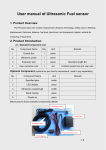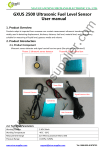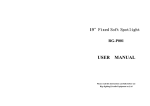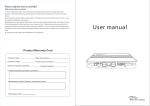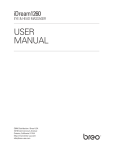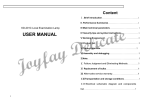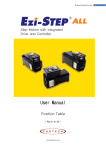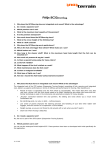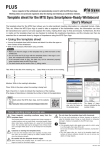Download Ultrasonic Fuel sensor User manual 1. Product Overview
Transcript
Ultrasonic Fuel sensor User manual 1. Product Overview Products adopt is imported from overseas non-contact measurement ultrasonic transducer technology, widely used in detecting displacement, thickness, distance, fuel level, material level, and transparency, suitable for measuring of liquid level, gaseous media and volume. 2. Product Introduction 2.1, Product Component Ultrasonic sensor detector and signal control box two parts( see picture1 and picture2) Picture 1: Ultrasonic sensor detector Picture 2: Signal control box Power Wire Signal Extension Wire Ultrasonic Detector Detector Control Box User Connector 2.2, Technical Parameters Working Voltage: 7-38V 60mA Working Temperature -40℃-80℃ Measurement Range 3.5-200cm Ultrasonic probe protection Level IP66 Master control box protection level IP61 Interface One way analog output0.1~3.0V,RS232 2.3,Product Feature 1. Easy installation and maintenance: only need to install the sensor below the external tank, don’t need change the original tank measuring system, don't need to make hole and change oil tank, and make sure the normal operation of the original car oil gauge; 2. Environmental protection no pollution, little energy consumption, non-contact measurement, don't need to make hole or tank modification cause to oil dirt and contamination. 3. Strong reliability: still work normally under the harsh environment, moistureproof, acid proof, flame retardant, anti-interference, and intelligent. This product can be used separately through data screen view directly, also be used with GPS devices, through the GPS device to transmit data to the server for data statistics, analysis and query statements. 2.4, Application Range The product is geared to all kinds of vehicles, such as (logistics cars, taxis, buses, commuter trains, etc.), to digital records vehicle refueling, the fuel situation, prevent the oil theft, avoid the waste of resources, improve operating efficiency, and traffic safety, strengthen the operation management of high-tech products. 2.5, Advantage Compare 1. Capacitance: Easily affected by the oil produce error; Do not produce electric spark; Punching installation. 2. Resistance-type: Mechanical measurement, error and lag, easy to corrosion, pollution because of long-term contact with oil , affect the accuracy of measurement, installation must be punched the tank. 3. Flowmeter type: Need to truncate the oil tube, inability to measure the amount of fuel charge, can only measure the usage amount, inconvenient calculation and management. 4. Reed pipe type: Low output accuracy; big effect by the measurement media and power voltage fluctuation of temperature; Components easy to magnetization; Measurement data are greatly influenced by fluctuations in the oil level and oil pollution, can’t not make field fabrication installation according to the height of the fuel tank . 5. Float type: the fuel can only be used for fuzzy instructions, cannot be used for oil metering, level of oil pollution of thin film resistance, power supply voltage, the mechanical structure, lubricity, etc., the reason of product itself, make larger influence on the long-term stability of the output value. 6. Ultrasonic type: using the non-contact ultrasonic measuring technology, high measuring accuracy, resistant to corrosion, anti-pollution, anti-explosion, easy installation, high stability, wide application. 3. Production Installation 3.1, Part List 1. Signal control box: one pcs 2. Ultrasonic detector: one pcs 3. Power wire: one pcs 4. Signal Extension Wire: one pcs 5. User Connector: one set 3.2, Installation Tools Preparation Complete set device, glue, cable tie, fine abrasive paper (500, 1000, 2000 size each one) , rags, a pail of water, ultrasonic complants, the multimeter, vehicle screw remove and installation tool and so on 3.3, Installation Diagram 4. Guarantee 1, one year warranty: repair, replacement and refund; free repair during warranty period, Lifelong maintenance. 2, During the warranty period, repair cause to freight cost paid by the sender.




